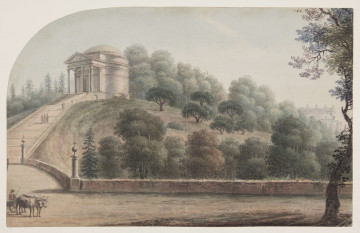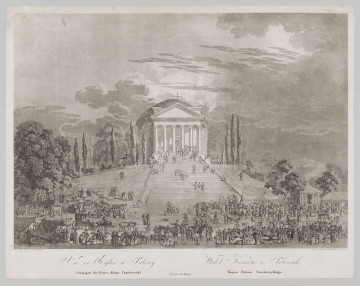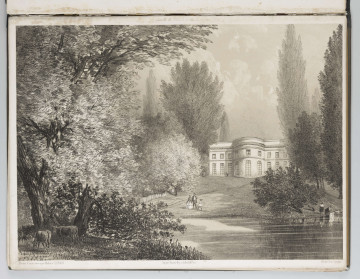
View of the Pantheon in Puławy
1799
National Museum in Lublin
Part of the collection: Lubliniana. Painting views of Lublin and the Lublin Region (17th–early 20th c.)
The view based on a design drawing by Chrystian Piotr Aigner (in the collection of the National Library) shows the Czartoryski Chapel in Puławy (since 1919 the parish church of the Assumption of the Blessed Virgin Mary). The building was founded by Adam Kazimierz and designed on his recommendation. The acceptance of the project was confirmed by the Prince General with his signature on 3 January 1800. Construction work began in the spring of the same year and was completed in 1803, with finishing work continuing until 1814.
The classicist chapel was situated on the north-western edge of the palace hill by the route leading through the Vistula River to Radom. The subtle silhouette of the building, modelled on the architecture of the Roman Pantheon, complemented the unique panorama of the area. Its picturesqueness was emphasized by the terraced, stone approach from the base of the hill to the chapel stairs.
The characteristic body of the building, in the form of a rotunda, with an adjoining portico with six Corinthian columns on the front, covered by a flattened dome, is distinguished by the perfection of its proportions and perfect architectural decoration.
On the beam of the portico, as in the Pantheon, an inscription is carved. The inscription in Puławy “THE ASCENDED MOTHER OF GOD” shows the chapel's calling related to the widespread cult of Virgin Mary and devotion to God through the intermediary of the Mother of God. Prince Adam Kazimierz also dedicated this building to the memory of his mother. This is expressed by the following dedication above the entrance door: “IN MEMORY OF THE FAITH AND VIRTUES OF MY BELOVED MOTHER / MARIA DUCHESS CZARTORYSKA NEE SIENIAWSKA W.R. / ADAM KAZIMIERZ”. The founder's mother, Duchess and Voivode of Ruthenia, died in 1771 and was buried in the Czartoryski family crypt in the Holy Cross church in Warsaw. She initiated the expansion and beautification of the Puławy residence after 1731. She also took care of the nearby church in Końskowola, where the ashes of her grandmother, Zofia Lubomirska née Opalińska, were buried. Adam Kazimierz commemorated both his parents. In the park in Puławy he erected their symbolic sarcophagus, modelled on the famous Roman tomb of Scypion Barbatus, made of white marble by the Roman sculptor Maksymilian Laboureur.
The fence with a column and sculptures of reclining lions, as well as the Classicist palace, visible on the drawing, were not realized.
Renata Bartnik
Author / creator
Dimensions
cały obiekt: height: 31,4 cm, width: 20,3 cm
Object type
painting
Technique
gouache
Material
paper, gouache
Creation time / dating
Creation / finding place
Owner
The National Museum in Lublin
Identification number
Location / status

1799
National Museum in Lublin

1806
National Museum in Lublin

1860
National Museum in Lublin
DISCOVER this TOPIC
National Museum in Szczecin
DISCOVER this PATH
Educational path